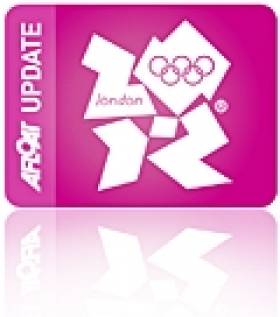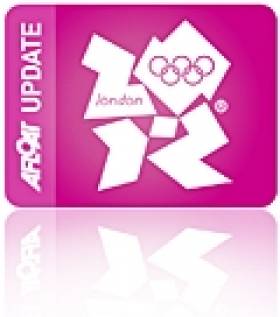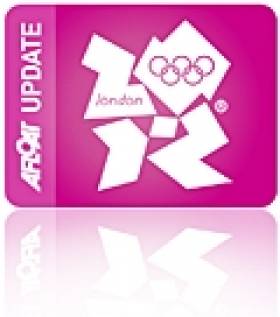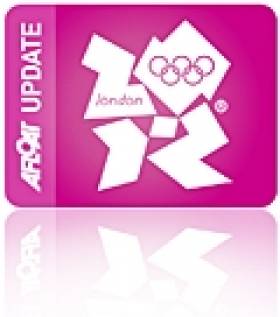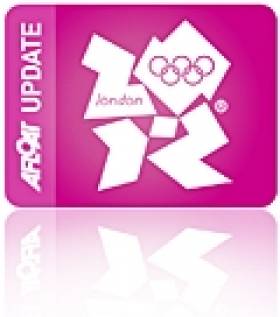Displaying items by tag: Keelboat
Scheidt and Prada Retain Star Crown in Perth
#PERTH2011– Today's Star medal race gave an invaluable glimpse at the make up of next Summers Olympic fleet. It's a point that won't be lost on Irish pairing Peter O'Leary and David Burrows who, although they didn't make the medal race cut, are qualified for the London Olympics and tipped by the Irish Sailing Association as medal prospects.
Brazilians Scheidt and Prada maintained their points lead on the final day of the Star event to secure their second World Championship title. It was a world class performance that sent out many messages to any would be rivals, not least O'Leary and Burrows, and demonstrated just how difficult it will be to take Olympic Gold next Summer.
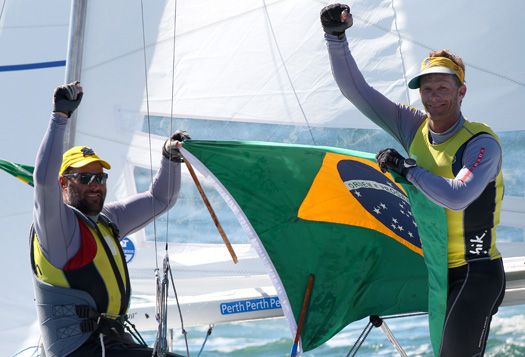
Sheidt and Prada retained their Star title at the ISAF Worlds today in Perth. Photo: Richard Langdon
The Brazilian's also won at the last ISAF Worlds in Cascais in 2007.
"To be Star world champion I think is the biggest achievement that a sailor can have," Prada said. "To win two times is to be a part of the story of Star class, it means a lot. The Star class is very special. It's the class of all the biggest names.''
The Brazilian duo were also presented with the 100-year-old International Star Championship Trophy, described as one of the most prestigious in world sailing, and the Mary Etchell's Bowl for world championship Star crew.
The silver medal went to Robert Stanjek and Frithjof Kleen (GER), while Mark Mendelblatt and Brian Fatih (USA) won bronze after an exciting and close Medal race fought out on Centre course.
Scheidt and Prada (BRA) started the day with a 20-point lead over the USA crew, who faced a tough battle for the silver medal against teams from Germany and Sweden.
Poland led the fleet in a 13-knot sea breeze for most of the race and crossed the finish line first, followed by Norway and the two German crews.
Fifth across the line in Bather's Bay, the Brazilian team had gained just 10 points which kept them within the margin needed to secure gold at the end of the Medal Race.
The duo, who won a silver medal at the Beijing 2008 Olympic Games, raised their country's flag after crossing the finish line to the cheers of delight and applause from fans in the grandstand.
After making its debut at the 1932 Olympic Games in Los Angeles, the Star has a long history in Olympic sailing but will bow out after the London 2012 Olympic Games.
"It's a big achievement because all my life when I was sailing Laser I was dreaming about sailing the Star and winning the World Championship one time, so managing to do it twice is a really big thing for me," Scheidt said.
"This year we have improved a lot in our sailing and our main goal was always to do well here in Perth, so coming through this year and managing to peak at this moment is very special.
"It means that we are on the right track for the 2012 Olympics."
German skipper Robert Stanjek said he was pleased with his silver medal after coming up against the Brazilian team.
"Yesterday we qualified for the Olympics and that was the aim of coming here. Now we are even happier. The silver medal is just a little extra on top."
"To sail against Scheidt is amazing because he is a legend in sailing," crew member Frithjof Kleen added.
Commenting on his bronze medal, American skipper Mark Mendelblatt said he had faced "tough competition" in Scheidt.
"I have been sailing against Robert Scheidt for 20 years," he said.
"The thing about him is he is very difficult to beat when he is at his best. Everyone has great regattas and not so great regattas. All we can do is improve our level."
Black Flag Setback for O'Leary/Burrows in Perth
#PERTH 2011 –There has been a setback to the Peter O'Leary and David Burrows Star keelboat campaign today following their disqualification from the sixth race when the Irish crew were lying second.

Star keelboats line up for a world championship start in Perth. The Irish Star was judged to be over the line in race six. Photo: Richard Langdon
It means the pair are now in a real fight to secure Olympic qualification. The top 11 nations will qualify for next year's Olympic regatta and the Irish pair are currently 11th nation. Swiss, Italian, Greek and Croatian rivals are all vying for the final slot and can still overhaul the Irish boat.
The pair were pulled from the race by officials who judged them to have been premature starters in race six. The subsequent disqualifcation drops them to 14th overall as they must now count the 33rd placing scored in race four.
After five races sailed the Dublin-Cork combination were only one point off third overall earlier today.
A post on the team facebook page today simply says:
Simpson said: "We had an okay run, but Iain hurt his back and was in tears. It looks like it's his lower back, but we don't know yet. No way could we have raced the second race."
"It's frustrating; sadly this is the second event in a row Iain has injured himself. He injured his ankle last time," he said. "I guess we won't be sailing, but we never rule anything out."
Shortly after the race, Percy said on his Twitter account: "My back fully went today half way through the first race. Unfortunately the end of the championships and the beginning of a few weeks of physio."
On the penalty that ended their race, Simpson said: "Sadly we picked up a yellow flag and we don't know why – we're still confused."
Race 5 was won by Mateusz Kusznierewicz and Dominik Zycki (POL), who led for the entire course.
Closely behind in second place were Robert Scheidt and Bruno Prada (BRA), well clear of the third placed German team, Johannes Polgar and Koy Markus.
In the sixth race, Scheidt and Prada had to settle for another second place after crossing the finish just two seconds behind Swedish pair Fredrik Loof and Max Salminen.
Finishing in third and with only one second separating them from the Brazilians were Kusznierewicz and Zycki.
After six races, Scheidt and Prada move into first position overall. Mendelblatt and Fatih (USA) and Kusznierewicz and Zycki (POL) trail the Brazilians by only one point.
O'Leary and Burrows Lie a Single Point off Third
#PERTH2011 – Keelboat pair Peter O'Leary and David Burrows are in a three way tie vying for third place overall after five races sailed at the Star world Championships in Perth today. The sole Irish contenders in the 42-boat fleet scored 11th in race five to put them on equal points with Brazil's Robert Sheidt and Poland's Matseix Kusznierewicz, former Olympic Gold medallists from the Laser and Finn classes respectively.
O'Leary, Schedit and Kusznierewicz all share 24 points, just one point shy of America's Mark Medendlatt and Brian Faith in the Bronze medal position. Although the Irish crew are shown sixth on the leaderboad after a single discard has been applied it could not be tighter as the event moves past the half way stage today. Race six results as we have them.
O'Leary and Burrows Ready for First Gun in Perth
#PERTH2012 – Hotly tipped Irish keelboat duo Peter O'Leary and David Burrows race tomorrow for Olympic qualification and world championship honours in the first race of the Star keelboat worlds, the second week of the ISAF World Championships in Perth.
Belfast Lough 49er dinghy triallists Ryan Seaton and Matt McGovern and Royal North Laser sailor, James Espey both start racing on Monday.
Solid Performance Moves O'Leary and Burrows up to Second
A very sold performance from Cork-Dublin pairing Peter O'Leary and David Burrows has produced second overall at the halfway stage of the Olympic Test event in Weymouth today. The pair are racing in a 21-boat fleet, a fleet size that will be reduced to 16 for the Olympic regatta next year.
World Number 1 Star duo Robert Scheidt and Bruno Prada had, by their standards, a bad day at office finishing second in Race 5 and ninth in Race 6. But with the discard coming into play they discard their ninth place and continue to lead on seven points. O’Leary and Burrows had a good day placing first in Race 5 and third in Race 6, working their way up from 11th at the first mark in race six.
O'Leary/Burrows move to second overall and Poland’s Mateusz Kusznierewicz and Dominik Zycki are third on 19 points. Canada’s Richard Clarke and Tyler Bjorn won Race 6 and with 40 points they sit in ninth place.
The Laser and 470 were on a lay day today.The Star rests tomorrow and it's back to business for second overall Annalise Murphy in the Laser radial and Ger Owens and Scott Flannigan in the 470.
ISAF Vote Could Wipe Keelboats from the Olympics
Today at ISAF's world sailing mid-year meeting in St Petersburg, Russia, the ISAF Events Committee passed a vote recommending that ISAF Council select the following events/equipment for the 2016 Olympic Games.
| Event | Men | Women | Mixed |
| Board and Kiteboard | Board and/ Kiteboard | RS:X/Kiteboard to be evaluated | |
| One-Person Dinghy |
Laser |
Laser Radial | |
| Two Person Dinghy (Spinnaker) | 470 | 470 | |
| Skiff | 49er | Evaluation | |
| 2 Person multihull | Evaluation | ||
The voting was on an alternative vote system (AV), meaning that this slate was the last one standing after the round of voting. Known as the 470 slate, if it survives the Council vote tomorrow or Saturday, it removes keelboats from the Olympics.
Far from unanimous, the final vote was 12 out of 21 members favouring the slate. The vote was despite some Star class big guns being in the room, such as 2000 Gold medalist Mark Reynolds and 2008 Gold medalist Iain Percy.
The word is that there is fierce behind the scenes politicking going on to overturn the Events Committee recommendation. Not only from the Star Class, but other interested parties such as Brazil who host the next games and are strong Star supporters.
Don't assume anything yet!
Irish Olympic Crews in Top Twenty of World Rankings
Peter O'Leary who has been sailing with three different crews, David Burrows, Frithjof Kleen and Timothy Goodbody to date is ranked 17th by the International Sailing Federation (ISAF).
O'Leary and Burrows sailing in the Star keelboat class were recent top finishers at 93-boat fleet in Miami. They finished second overall after they lost the overall lead in the last race of the 2011 Bacardi Cup.
Listen into a podcast about Peter O'Leary's Olympic sailing plans HERE.
Fellow Olympic squad member, 21-year old Annalise Murphy from Dun Laoghaire is now ranked 12th in the Laser radial class counting seven ISAF events. Murphy has also had success in Florida this season, she finished fourth in the Miami Olympic Classes regatta in January.
Listen to what Team Manager James O'Callaghan has to say about her progress:
The next release of the ISAF World Sailing Rankings will be on 13 April 2011 and will include the Trofeo SAR Princess Sofia Mapfre in Spain.
The ISAF World Sailing Rankings rate skippers based on their performances over the last two years. Skippers score points by competing in ISAF Graded events. The top finishers at all ISAF Graded events score Rankings points, with the highest points awarded to the event winner and then decreasing down relative to position.
More Irish Olympic Sailing News HERE.
Annalise Murphy is Miami Medal Prospect
The strong Dun Laoghaire girl relished the prospects of the big winds that blew at times on Biscayne Bay this week. Consistent results of 5, 15, 2, 2, 5, 6 11,9, (21) and 5 never saw her out of the top five.
Tuesday saw her bag two second places in a fleet of 58. It was a turning point in a regatta that she crashed out of last year only to return wth grit to be Ireland's only medal hope today.
Last night's move up to fourth overall on the scoreboard is another confidence boost, heightening the prospect of a place on this evening's podium. Conditions in Miami today are forcast to be light, probably not the conditions the National Yacht club girl would have hoped for.
In the Star Peter O'Leary and his crew for his London 2012 bid David Burrows finished with a strong fifth place yesterday but it was not enough to make today's final. They finished 13th overall after counting a black flag disqualification on day two of the event. See all results HERE.
Rival to Annalise, Tiffany Brien from Belfast Lough finished 21st overall.
Her club mate Jame Espey was 49th out of 52 after 7 races in the Laser gold fleet.
More from Miami organisers below:
Waking to a brisk northwesterly breeze, sailors at US SAILING’s Rolex Miami OCR yesterday made up for races lost to light air Wednesday. The conditions, though chilly by Florida standards, played out perfectly for medals to be determined in three Paralympic classes, while 10 Olympic classes fought their final battles for the right to compete in tomorrow’s medal races, which are comprised of top-ten “sail-offs” for Finn, 49er, Men’s 470, Women’s 470, Laser, Laser Radial, Men’s RS:X, Women’s RS:X and Star classes, and Finals and Petit Finals for Elliott 6m (women’s match racing). The regatta, which began Monday for 716 sailors from 53 nations, prepares Olympic and Paralympic sailing aspirants for the 2012 Games and is the second of seven stops on the International Sailing Federation (ISAF) Sailing World Cup circuit.
For France’s Damien Seguin, a two-time 2.4mR IFDS World Champion who is currently ranked #1 in the world, winning gold in the Paralympic 2.4mR class was looking good from day two when he assumed the lead over his 30-boat fleet. Clinching today, however, was not as straightforward as today’s scores seemed to reflect. Following seven boat lengths behind leader USA’s John Ruf (Pewaukee, Wis.) at the finish in race one, Seguin was determined the actual winner when Ruf was disqualified for starting the race prematurely and neglecting to exonerate himself. “After that, for my next two races, my score was such that I needed only to loosely cover Thierry Schmitter (NED),” said Seguin, further explaining that only if he finished worse than sixth would he foil his own plot. Schmitter, another IFDS World Champion, took the Silver Medal, finishing fourth in the first race and winning the next two, each time with Seguin behind in second.
“There were many different winds here,” said Damien about the practice this provides for his run for a spot on the French national team. “We started in strong wind, then there was light wind and today medium-strong. I am very happy for that and for the competition.”
Taking bronze was Canada’s Allan Leibel, who is able-bodied and allowed to compete here, since the class is declared “open” for this event.
The Gold Medal taking in the Paralympic Sonar class by GBR’s John Robertson/Hannah Stodel/Steve Thomas came with an intriguing twist today. With two races completed, the Dutch team of Udo Hessels/Mischa Rossen/Marcel van de Veen were in the lead, and surprisingly, they did not sail the third and final race.
“There were two points between us and the Dutch, so no one will ever know how it would have played out on the water,” said Robertson, explaining that he understands Hessel’s middle crew Rossen, a single-arm amputee, had been having problems with his opposite shoulder and the team had decided beforehand to race no more than two races today.
Robertson’s team, which took the Silver here last year, posted a final score of 30 to the 36 points posted by silver medalists Bruon Jourdren/Eric Flageul/Nicolas Vimont Vicary (FRA). The Dutch team, with 37 points, is going home with the Bronze.
As for his team’s overall strategy here, Robertson said, “We tried to sail our own race and not get hung up with the other guys. Hanna did a fantastic job calling tactics, especially today, as the wind was up and down and all over the place, with 40-50 degree shifts.”
The Australian Paralympic SKUD 18 team of Daniel Fitzgibbon/Liesl Tesch has led their fleet since day one and boasted six victories in their nine-race score line to take the Gold medal. Today they finished 1-1-2.
“We didn’t walk away with it, really, but we were comfortably ahead,” said Fitzgibbon, who won a Paralympic Silver Medal (with a different crew) in Qingdao. "We didn’t expect to have done so well with such a new combination,” he added, noting that he and Tesch, who gave up Paralympic basketball (she is a two-time medalist) for her new-found love of sailing, have only been together on the SKUD 18 for a few weeks. “It’s a new challenge for her and a breath of fresh air for everybody.”
Taking Silver was US Sailing Team AlphaGraphics’ Scott Whitman/Julia Dorsett (USA), with Alexandra Rickham/Niki Birrell (GBR) taking the Bronze.
Medal Races Tomorrow
Top-ten finishers from today in each of nine Olympic classes will get only one chance--a 30- to 40-minute race—to make or break their claim to a podium position. Emulating the Olympic format, the medal race counts double points and cannot be counted as the one allowed discard race when it is added to a sailor’s score line from the rest of the series.
In women’s match racing, US Sailing Team AlphaGraphics members Anna Tunnicliffe(/Molly Vandemoer/Debbie Capozzi (Plantation, Fla., USA/Redwood City, Calif./Bayport, N.Y., USA) will meet Claire Leroy/ Elodie Bertrand/Marie Riou (FRA) in a first-to-three points Finals match tomorrow to determine Gold and Silver medalists. Lucy Macgregor/Mary Rook/ Kate Macgregor (GBR) and Sally Barkow (Nashotah, WI., USA)/ Alana O’Reilly (Charleston SC, USA)/ Elizabeth Kratzig-Burnham (Miami Beach FL, USA) will be fighting for bronze in the Petit Finals.
Match racing starts on its own course at 9:30 tomorrow, with fleet racing starting at 11:00 am on two additional courses. Fleet races are planned to be approximately 30 minutes in length and started 40 minutes apart. No racing will start after 1:40 p.m., so it will be an early day.
US SAILING has partnered with the city of Miami to provide world-class venues for competition. Additional hosts for the event include Coral Reef Yacht Club, Key Biscayne Yacht Club, Coconut Grove Sailing Club, Miami Rowing Club and Shake-a-Leg Miami. These sailing organizations host classes onshore, as well as help run the on-the-water racing. The Coral Reef Yacht Club also hosts the Opening and Closing Ceremonies.
In addition to title sponsor Rolex Watch U.S.A., US SAILING’s 2011 Rolex Miami OCR is also sponsored by AlphaGraphics, Gowrie Group, Chubb Insurance, Sperry Top-Sider, Harken McLube, Trinity Yachts, University of Miami Hospital and Kattack.
A complete roster of competitors can be viewed at the event website, RMOCR.ussailing.org, where real-time racecourse blogging, commentary and fan interaction, regatta results, photos and news updates will be integrated into a live coverage platform once racing begins. Video highlights produced by Gary Jobson and presented by Rolex air daily and are available on-demand on the event website. Fans can also follow the event on Facebook/RolexMiamiOCR and Twitter/RolexMiamiOCR.
More in our Olympics 2012 category HERE
Finn Fights to Stay Olympic Dinghy Class
The Council are going to be asked to confirm six core events and these it is understood will most likely will be Men and Women Boards, Laser and Laser Radial and Men and Women Skiff.
Once these are selected the other four events will be considered and the Olympic Commission has suggested that 4 of the following 6 be picked:
Men's Heavyweight (Finn)
Women's other weight division in singlehanded
470 mixed
Multihull mixed
Men's Keelboat
Womens Keelboat
With the commission recommending equal gender balance, the Finn is unlikely to stay on its own and would need another women's singlehander to be selected.
The multihull is almost certain to get in, and there probably will be strong support for men and women's keelboat leaving it to be fought out between the Finn, the 470(mixed) and a Women's single handed dinghy.
Many believe the second decision will be deferred until May, but as one ISAF insider told Afloat.ie "I would be selling my Finn now if I had one".
Meanwhile the Finn class association don't see it that way at all. Under the threat of possible deselection the heavyweight men have been mobilising for a fight. Below are details of its recent campaign to stay an Olympic boat. Scroll down for nice Video too.
International Finn Association Press Release
The Finn - an outstanding display of sailing skills and athleticism
The Olympic Commission set up by ISAF delivered its preliminary report at the ISAF Conference in May 2010. Based largely on the Olympic Commission report, the ISAF Executive has since published two submissions which outline an exciting new future for the selection and decision making process for Olympic sailing events and equipment. The Finn is positioning itself to be part of that future.
Among the submissions are proposals for two sets of single-handed dinghies for both male and female sailors, to represent the weight and size distribution of modern youth of both genders in the most popular and low-cost type of dinghy sailing. The Finn class supports this idea.
Here are some of the arguments why Finn sailors think the Finn should remain part of the Olympic sailing equipment.
Tough challenge
The Finn is widely regarded as one of the toughest physical challenges in sailing. Sailors have to be tough, strong, fit, agile and athletic, while managing the mental aspects of racing at the highest level. The current world champion has a VOR max comparable with marathon runners and cross country skiers. Winning takes dedication, commitment and performing at the limits of fitness and endurance.
Appealing racing visuals
Modern looking rigs and hulls. Beautiful boat to sail with athletic, fit, muscular sailors. Requires extreme physical effort to sail well. Golden sail insignia for former world champions from 2011. Continuing research into sailor identification and country flags on sails. The free pumping rule has transformed downwind sailing into an absorbing display of skill, strength and athleticism.
Standard boats
Finns can be bought 'off-the-shelf' and be winning the next day. Hulls, masts and sails have all evolved into a level plateau of standardisation that means boats can compete on a level playing field. The strict class rules limits any experimentation into 'super' boats. Boats that are sold year after year are identical within reasonable limits and do not change perceivably over time.
Low costs
The Finn has one of the lowest running costs of any Olympic equipment. Average campaign costs from 35 sailors was just EUR 7,500 a year. One boat can last at least two Olympic cycles. Gear standardisation has meant reduced development costs. Gear is fast and ready to sail 'out of the box'. Increasing IHC and building control is reducing regatta measurement requirements, while 99% of checks at regattas pass first time.
Consistent equipment
Today's Finns are the most consistent, accurate and reliable Finns ever built. A modern Finn can be expected to be competitive for 6-8 years. The Finn is one of the most consistent hulls made today, thanks to very professional builders and strict measurement rules. Modern materials and new technologies means that boats supplied all over the world are as alike as possible in almost every way.
Easier rules
A proposal was passed at the 2010 AGM to lower the free pumping limit to 10 knots. This was aimed to make Rule 42 enforcement easier for judges and sailors. Under 10 knots there are much less opportunities for pumping and surfing. Identifying illegal activity is much easier, so less emphasis on judging decisions. Sailors are educated in Rule 42 – frequent clinics with the active involvement of judges and website coverage.
Worldwide culture
Local builders are producing low cost Finns for regional competition. Having been on the Olympic Programme since 1952, the Finn has the deepest culture and traditions of any dinghy class. Semi-professional class organisation oversees all activities. All levels of competition from Juniors (U21) to Masters (40+) and everything in between. Many countries are developing Junior programmes to fast track talented sailors.
Global spread
Finns are now built in the UK, Poland, Hungary, Czech Republic, Brazil, USA and South Africa, and there are other countries to come. Elsewhere, suppliers and dealers feed local fleets with new and used equipment. There are National Finn associations in more than 50 countries, while between 35 and 40 countries have internationally active sailors. Sailors from six continents attend major regattas. It is truly a global fleet.
Pinnacle event
The Finn is the pinnacle of singlehanded dinghy sailing for men, and the Olympics is the pinnacle event for the Finn. It provides a single step pathway from Optimist to Laser to Finn as the sailor's weight increases, but also allows the development of similar technical and physical skills in the sailor through a natural progression of similar equipment.
What the sailors say:
Jonas Høgh Christensen (DEN), 2006, 2009 World Champion, "The Finn is the most fun, challenging boat for strong, athletic sailors."
Giorgio Poggi (ITA), 2008 Finn Olympian, "The Finn is the class where the sailor must be complete."
Zach Railey (USA), Silver medalist, 2008 Olympics: "For single handed sailing the Finn is my only option given my weight and height to pursue my Olympic sailing dreams. With the technical and physical demands of the boat, the Finn is a pure test of a sailor's ability to react to the changing conditions on the race course under intense physical exertion."
Rob McMillan (AUS), "There is no other boat like it. The advent of free pumping brings a level of athleticism that is unique to the Finn."
Daniel Birgmark (SWE), 4th 2008 Olympics, "Sailing the Finn puts very high demands on the sailors athletic capacity as well as tactical and strategic skills. It's the perfect singlehander for sailors over 85kg."
Tomas Vika (CZE), one of many Finn sailors in their early 20s, "If you are more than 180cm tall and you want to work on your physical condition in a gym you will always weigh more than 85kg and that is the reason why Finn has to stay as an Olympic dinghy in future years."
Gus Miller (USA), Finn legend: "It's a very powerful demanding boat and you need a lot of initiative and attitude that you're going to do it yourself. Everyone realises the challenges is yourself not the other guys. The challenge is the boat and that understanding is the old idea "I love my competitor because he makes me better". The guys here have enormous respect because the challenge of sailing the boat is so great. If one guy figures it out then the others guys are glad for him that he's been able to do it."
Caleb Paine (USA), first Junior, 2010 Finn Gold Cup: "The Finn is the best class I have sailed in. There isn't I class I know of that has such a great sense of camaraderie. After my first international regatta I knew all the best Finn sailors in the world on a first name basis because they were open, friendly and supportive of the new kid. I think that this coherence of the class stems from the fact that the sailors often train together. This builds friendships as well as making everyone better."
Tapio Nirkko (FIN), 2008 Finn Olympian: "The Finn is already well developed in many areas. We're now in a situation when all the Finn equipment (hull, mast, boom, rudders, centreboards) are good quality and last a long time. When the market is competitive, the price of the equipment is also fair and resale value is good. That's an important factor to make a competitive Olympic project from a small country with a small budget. Now the actions made in the class to make equipment issues more transparent is important to keep Finn as a class where it's possible to make it to the top without having a monster budget."
Ed Wright (GBR), 2010 World Champion, on what makes the Finn class special for him: "For a start it's visually pleasant. The cost is low. I still use my first mast and it's still fast after five years. .... You can gain little advantages everywhere, but you have to treat the Finn with finesse, respect and grunt to keep it up to speed. The people in the class are great people and all hard competitors. Also there is so much history in the class, and never forget the many legends coming from the Finn."
Read more from these interviews and more about the Finn in the latest issue of FINNFARE out now



























